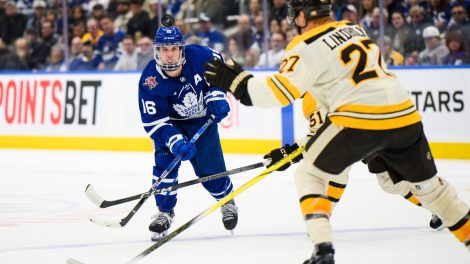Last year around this time, with the help of some smart people, I posted a series of articles ranking the top 20 NHL players at each position over the previous three seasons. We’re going to do the same thing this year, but change things up fairly significantly as well.
Like last year, the list will be limited to players who have participated in 2000-plus 5-on-5 minutes over the past three seasons in order to get an adequate sample size of play to draw from, so players such as Auston Matthews, Patrik Laine, and Zach Werenski don’t make the cut, though we will have something on Matthews after the rankings are complete.
Like last year, this is a complicated task that requires outside input, and whenever I take on a project this large I like to rely a little on people smarter than myself. The framework of the rankings is built on the input I got last year from Dom Luszczyszyn, Steve Burtch, and Jonathan Willis, while this year I received additional input from Luszczyszyn again and Dominic Galamini, as well as the ideas of smart people like Manny Perry and Tyler Dellow.
Statistics for this project were collected from Sportlogiq, Natural Stat Trick, Puck IQ, Hockey Reference, NHL.com, and Luszczyszyn’s Game Score database. Each statistic was individually weighted in categories, scored as a percentile from the highest score at the position in order to award a score to each player.
This year for all forward positions I adjusted the categories slightly, taking five points from transition play and adding it to offence, while adding a new category for difficulty of minutes played that is applied as a multiplier to all categories. As such, the highest theoretical score would now be 125 points instead of 100 if a player were to be the best in the NHL at every single statistic while playing the toughest minutes in every category in the difficulty matrix, but no one scores that high so practically we’ll keep the numbers out of 100 even after the adjustment.
Also new this year is weighting season scores by how recent they are, using the same breakdown Galamini does with his HERO charts: 22.2 per cent for 2014-15, 33.3 per cent for 2015-16, and 44.5 per cent for 2016-17.
Here are the statistics used in each category:
For offence: 5-on-5 and power play goals, primary assists, secondary assists, scoring chances, high-danger scoring chances, scoring chances generated for teammates, shot attempts, passes to the slot completed, penalties drawn, and on-ice goals for relative to teammates per 60 minutes, and offensive zone pass completion rate.
For transition play: 5-on-5 outlet passes, stretch passes, controlled carries out of the defensive zone, neutral zone passes, controlled entries into the offensive zone per 60 minutes, Corsi, and Corsi relative to teammates, faceoff win percentage and pass completion rates relative to teammates in the defensive and neutral zones.
For defence: 5-vs-5 and shorthanded loose puck recoveries by zone, pass blocks, stick checks, body checks, penalties taken, on-ice goals-against relative to teammates, on-ice shot attempts against relative to teammates per 60 minutes, and turnover rates relative to teammates by zone.
For difficulty of minutes played: Puck IQ’s competition faced percentages, Game Score’s quality of competition, Game Score’s quality of teammates, PDO, offensive zone starts percentage, 5-on-5 time-on-ice, and overall time-on-ice.
With all that information out of the way, let’s get to the rankings. This year we’re adding a few extra, doing the top-23 at each position. For the centre position, 107 players qualified.
23. Derek Stepan
Difficulty Matrix: 1.15/1.25
Offence: 28.16/50 | Transition: 14.00/25 | Defence: 19.32/25
Total: 61.47/100
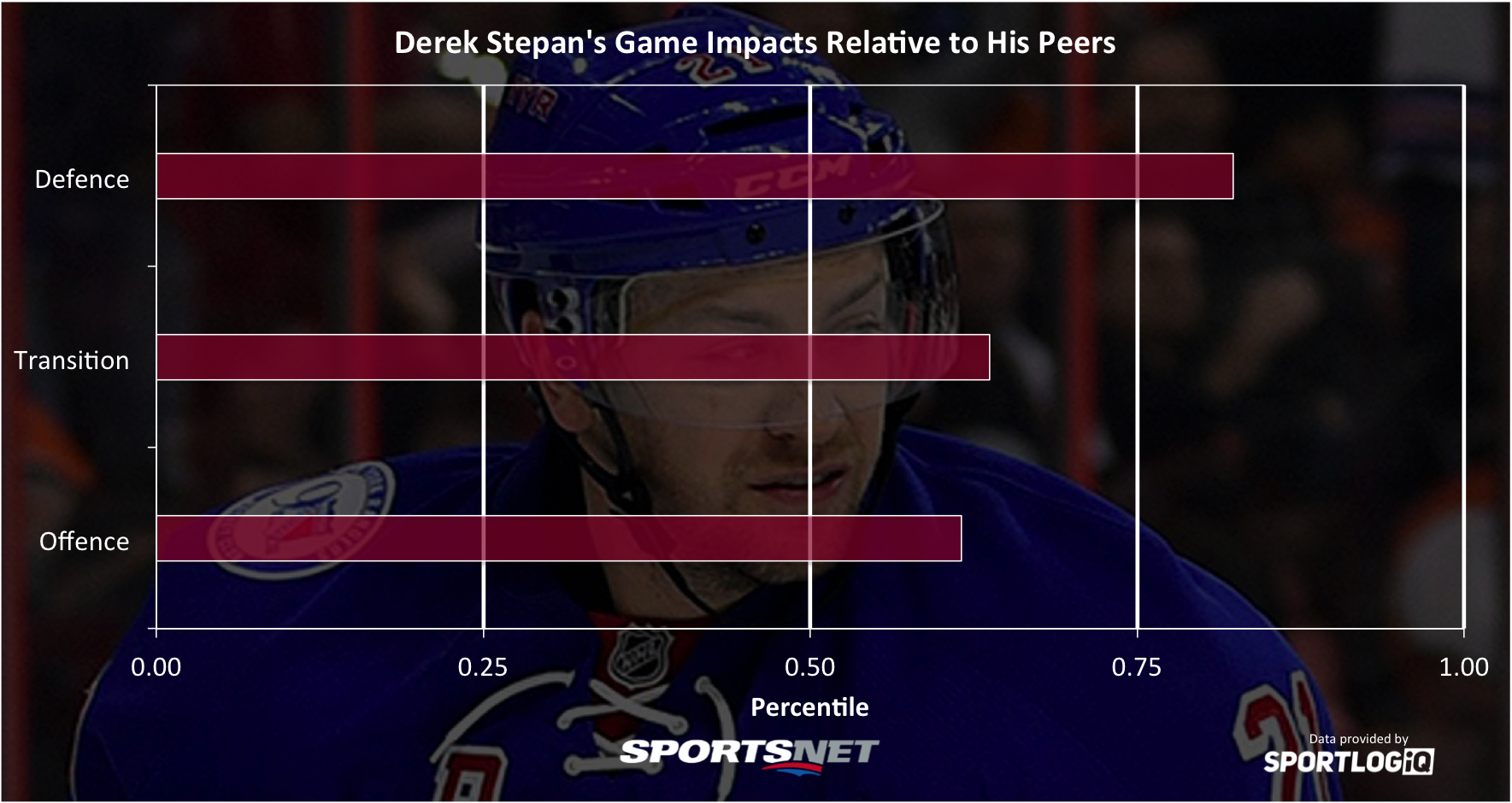
One of the interesting things about this project is learning some players are much better than you think, and colour me shocked that Stepan ranks this highly among centres in the NHL. Where Stepan stands out most is defensively, where he’s a strong penalty killer and even strength defender, not necessarily due to aggressive tendencies in recovering the puck, but due to careful puck management and good choices. Stepan very rarely turns the puck over, especially in dangerous areas, which allows his team to regroup around him and face fewer dangerous chances while he’s on the ice.
Stepan pairs his strong puck management with above average offensive and transition skills, making him one of the better centremen in the NHL over the past three seasons. He should provide a serious boost to the Arizona Coyotes roster, and the Rangers will have to hope Lias Andersson and Anthony DeAngelo work out, or else that trade looks lopsided.
22. Tyler Seguin
Difficulty Matrix: 1.17/1.25
Offence: 38.06/50 | Transition: 12.82/25 | Defence: 12.00/25
Total: 62.88/100

One of the most dynamic offensive players in the game, it’s a bit of a shock to see Seguin so low on the list after ranking eighth last year, but his lost 2013-14 season combined with a fairly severe collapse in his transition game over the past two seasons leads to a huge drop for him.
Seguin’s offensive prowess is almost unequaled, but he’s struggled to connect on passes outside the offensive zone, turning the puck over a shocking amount, and relied on his teammates to move the puck up the ice too often. Considering his previous strength when it comes to skating with the puck, a fair amount of his drop in effectiveness has to be related to the injuries he’s suffered in recent years. A fully healthy season should see Seguin rocket back up into the top 10.
21. Jordan Staal
Difficulty Matrix: 1.17/1.25
Offence: 26.85/50 | Transition: 18.82/25 | Defence: 17.69/25
Total: 63.36/100
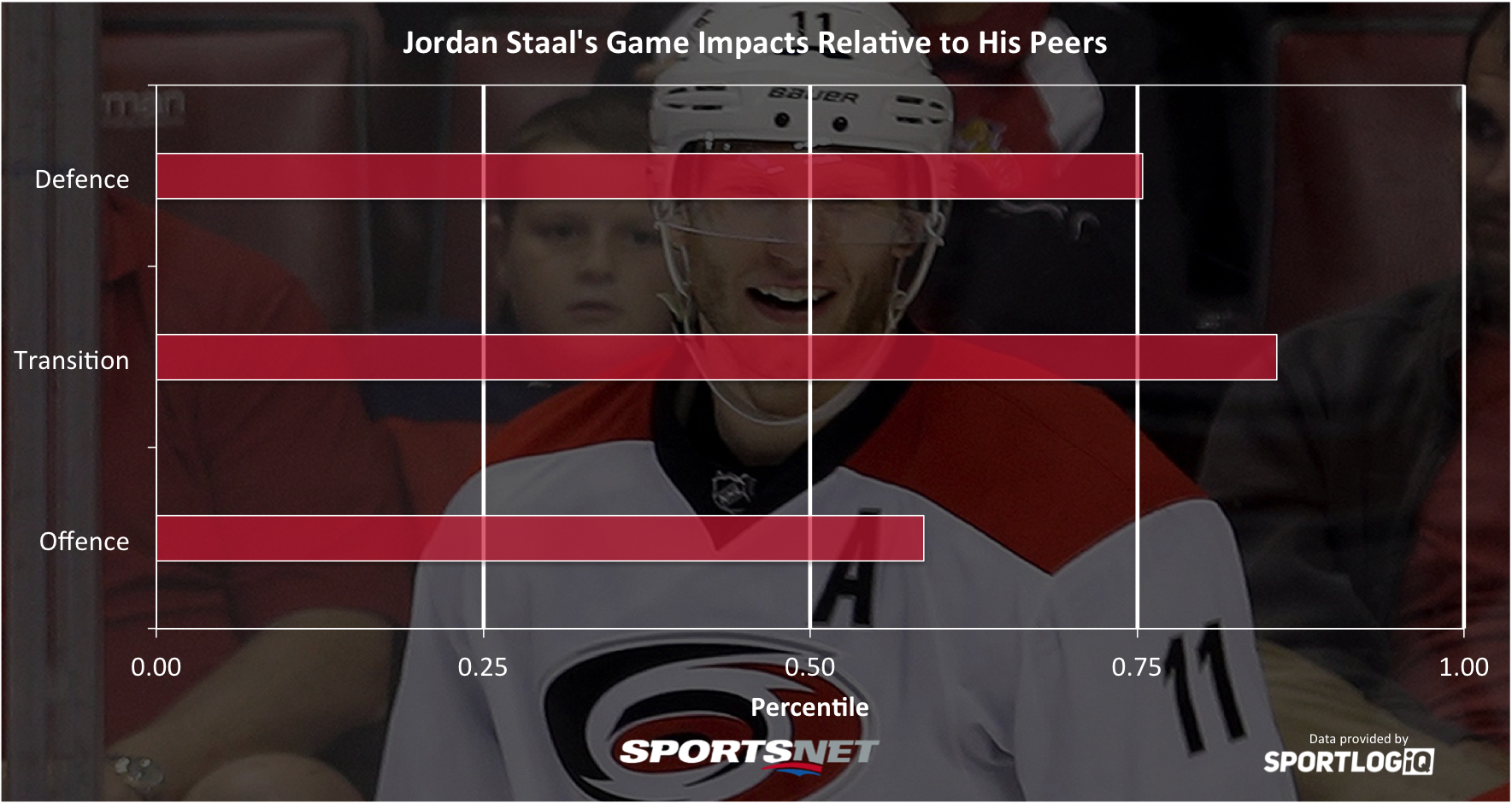
Long a favourite of the more analytically minded people in the hockey community, Jordan Staal is perpetually underrated by most. He may not be the elite offensive producer you want in a top-line centre, but Staal’s exceptional transition game allows for more offensive opportunities for his linemates, even if his individual offensive skills may not be at a first-line level.
When you couple that with his excellent defensive play in very tough minutes, you’ve got a player any franchise would love to have, and a perfect fit for a progressive team like the Hurricanes. Staal is a Corsi monster and one of the NHL’s best players at exiting the defensive zone and entering the offensive zone with control.
20. Joe Pavelski
Difficulty Matrix: 1.16/1.25
Offence: 33.94/50 | Transition: 14.73/25 | Defence: 14.96/25
Total: 63.63/100

Pavelski is mostly known as a goal scorer, some would say one who has mostly benefitted from playing with a near-generational talent in Joe Thornton, but he’s more than that when you look at the details. While it’s true Thornton has boosted Pavelski’s offensive numbers over the years, he’s a strong offensive player in his own right, and plays a balanced game that allows him to be very versatile.
No one in the NHL is better at deflecting pucks on net than Pavelski, which is his truly elite skill, but he’s also a very strong puck manager in all three zones, producing very few turnovers relative to his peers. If Pavelski has a weakness, it’s in battling for loose pucks, he could be a bit more aggressive there, but his biggest strength is simply that he’s good at almost everything.
19. Leon Draisaitl
Difficulty Matrix: 1.13/1.25
Offence: 31.78/50 | Transition: 19.06/25 | Defence: 13.09/25
Total: 63.93/100
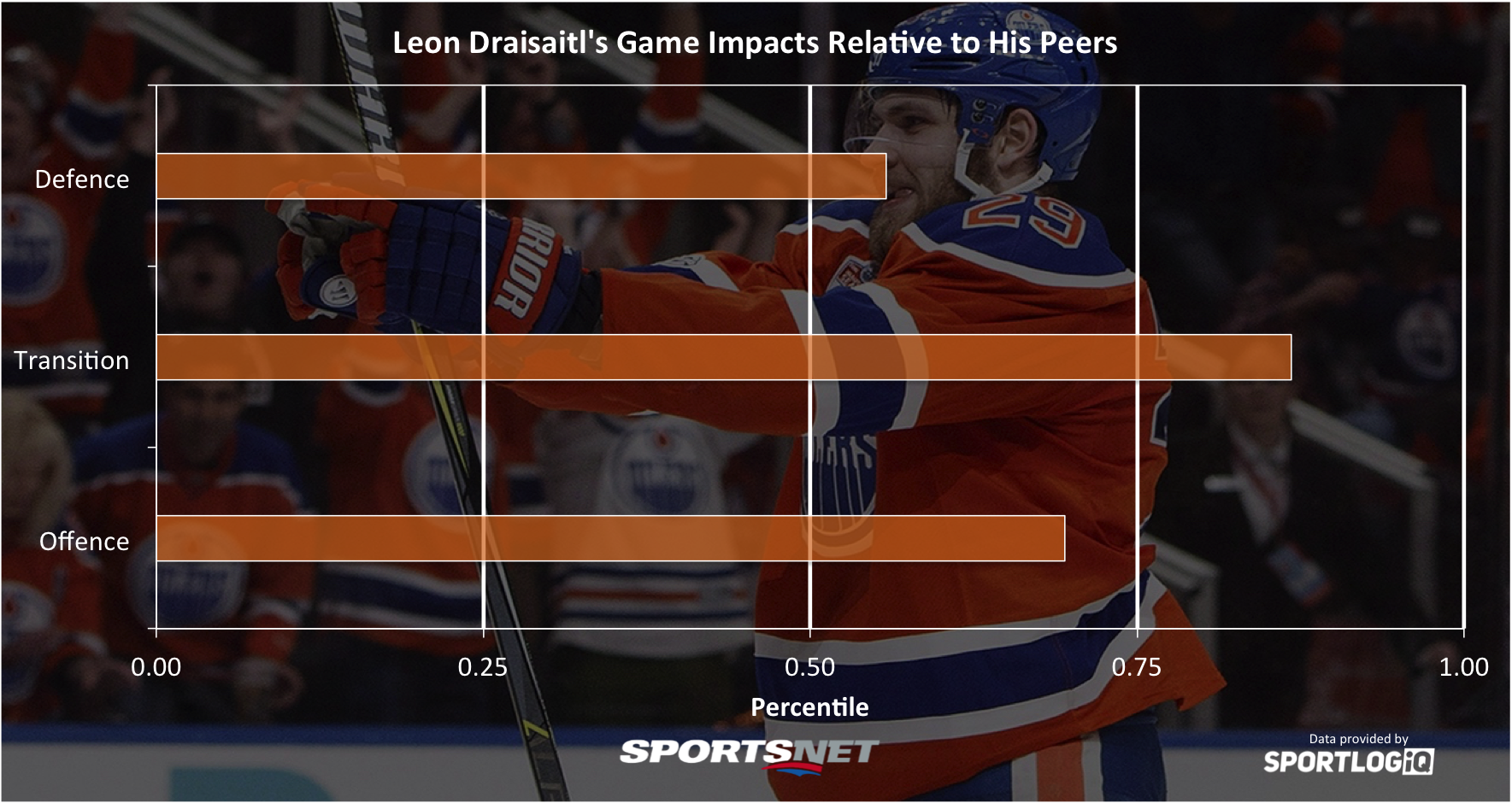
I have a few reservations about Draisaitl personally, as he’s spent most of his career riding shotgun with two elite players, either Taylor Hall or Connor McDavid, but his individual contributions were much stronger than I expected when I started the project. Draisaitl probably isn’t an 80-point player offensively (that’s extremely rare in today’s NHL), but his transition game is incredible and should make him a centre who makes his linemates better.
Already in his young career Draisaitl is among the best when it comes to skating the puck up the ice, and adds a dimension of danger off the rush with a flair for neutral zone passes that change the point of entry and put defences on their heels. Draisaitl is no great shakes defensively as of yet, but he’s also just turning 22 under a month into the season. There’s room for him to grow to be even better, and playing softer minutes behind McDavid should help him out.
18. David Krejci
Difficulty Matrix: 1.15/1.25
Offence: 28.43/50 | Transition: 19.00/25 | Defence: 16.91/25
Total: 64.34/100
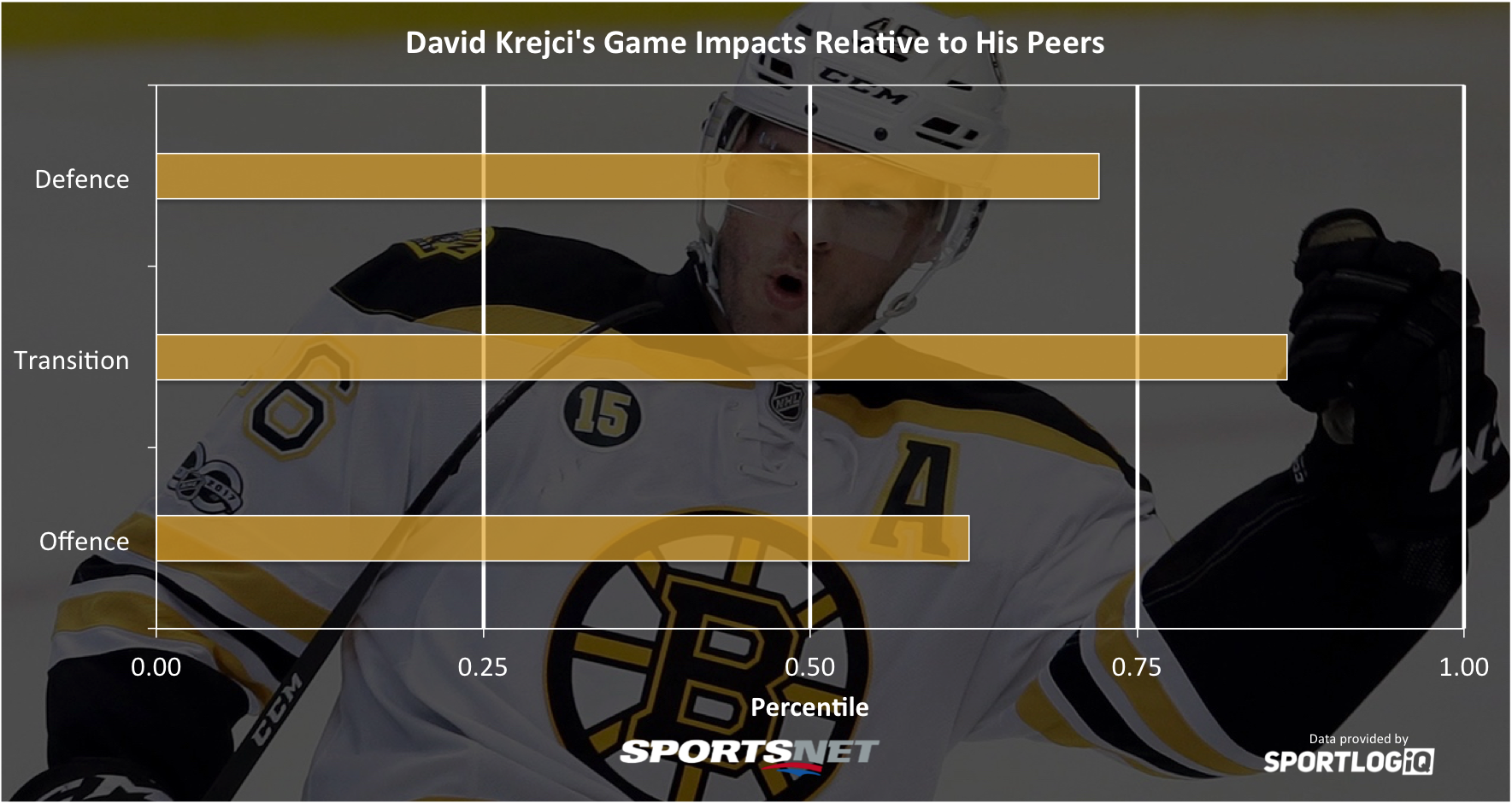
Krejci is another player who is pretty consistently underrated, which is probably bound to happen when you play behind Patrice Bergeron, who is incredible and absorbs a lot of the spotlight. At 31 years old his peak offensive years are behind him, but Krejci remains a strong offensive contributor, and an excellent transition player, along with being very strong defensively.
His biggest strength is in his puck distribution, where he contributes a high volume of passes that connect at an extremely high rate. That style of play can be hindered when he’s stuck with linemates who can’t do as much with the puck, but his smart passing keeps him among the most effective centres in the NHL.
17. Evgeny Kuznetsov
Difficulty Matrix: 1.12/1.25
Offence: 36.60/50 | Transition: 15.96/25 | Defence: 11.84/25
Total: 64.39/100

Up one spot from last year, Kuznetsov is essentially the same player he was previously, a bit of a liability on the defensive side, and playing the cushiest minutes of any centre to make the top 23 this year. He’s a spectacular offensive player who creates scoring chances at an elite rate at even strength with high-end playmaking skill and a nose for loose pucks near the net.
While Kuznetsov is one of the NHL’s best centres in creating controlled exits and entries, his play in the neutral zone is a bit sloppy, with lots of missed passes and turnovers that he could clean up on to take another step towards the NHL’s elite.
16. Mikael Backlund
Difficulty Matrix: 1.16/1.25
Offence: 29.61/50 | Transition: 18.45/25 | Defence: 17.41/25
Total: 65.48/100
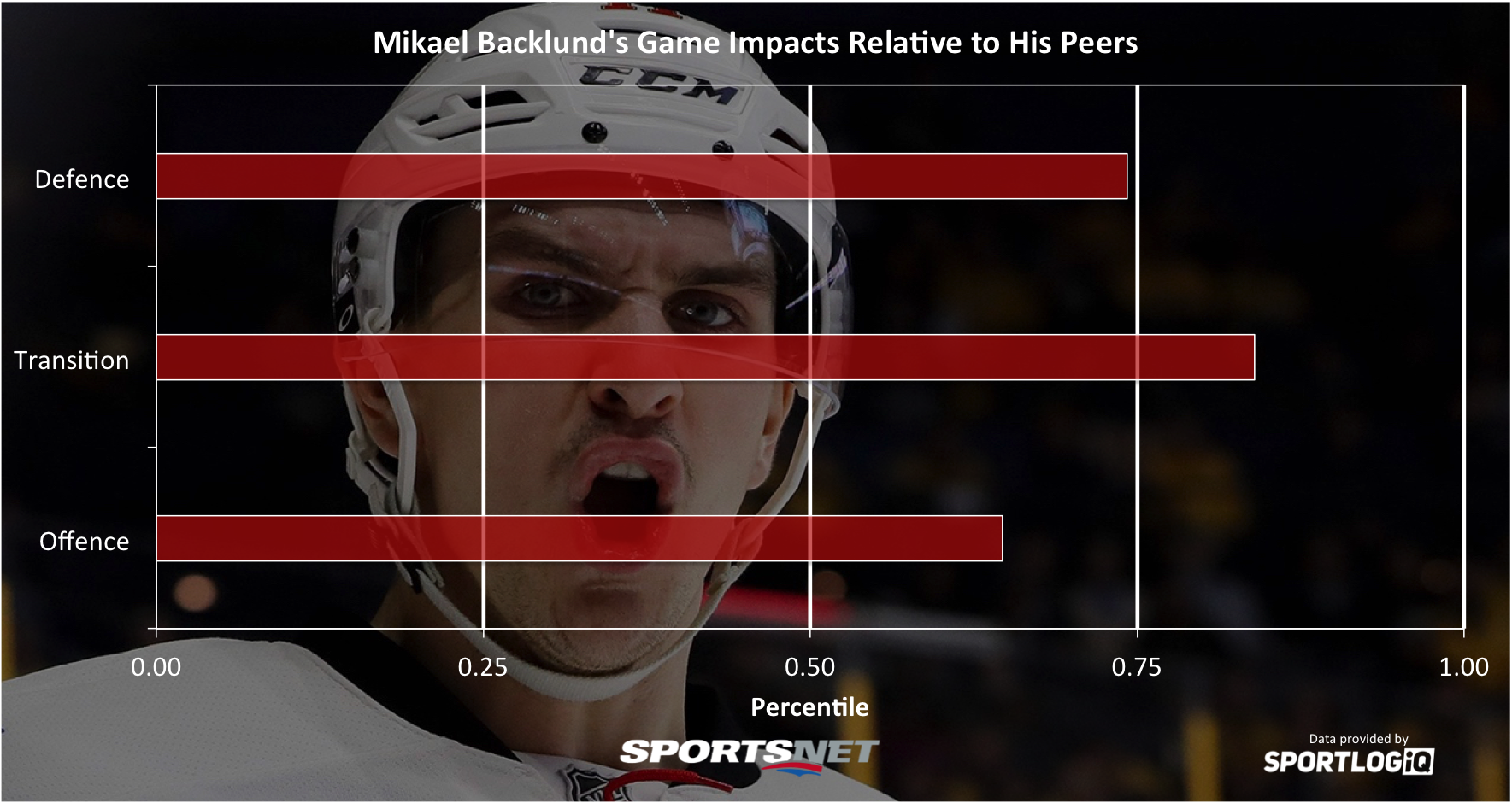
If you pay any attention to analysts who follow the Flames, you’ll have heard them singing Backlund’s praises for years now. For a long time he was a big possession driver who didn’t produce much offence, but that has begun to change with back-to-back 20-goal seasons. Backlund’s profile is surprisingly similar to Jordan Staal, only with a bit more offensive punch.
Backlund is one of the NHL’s better neutral zone players, creating danger off the rush with smart passes preceding entries in a similar way to Draisaitl, and is one of the NHL’s leaders in controlled exits out of his defensive zone. He’s an extremely intelligent player who is difficult for opponents to neutralize.
15. Jack Eichel
Difficulty Matrix: 1.20/1.25
Offence: 35.12/50 | Transition: 18.16/25 | Defence: 12.74/25
Total: 66.02/100
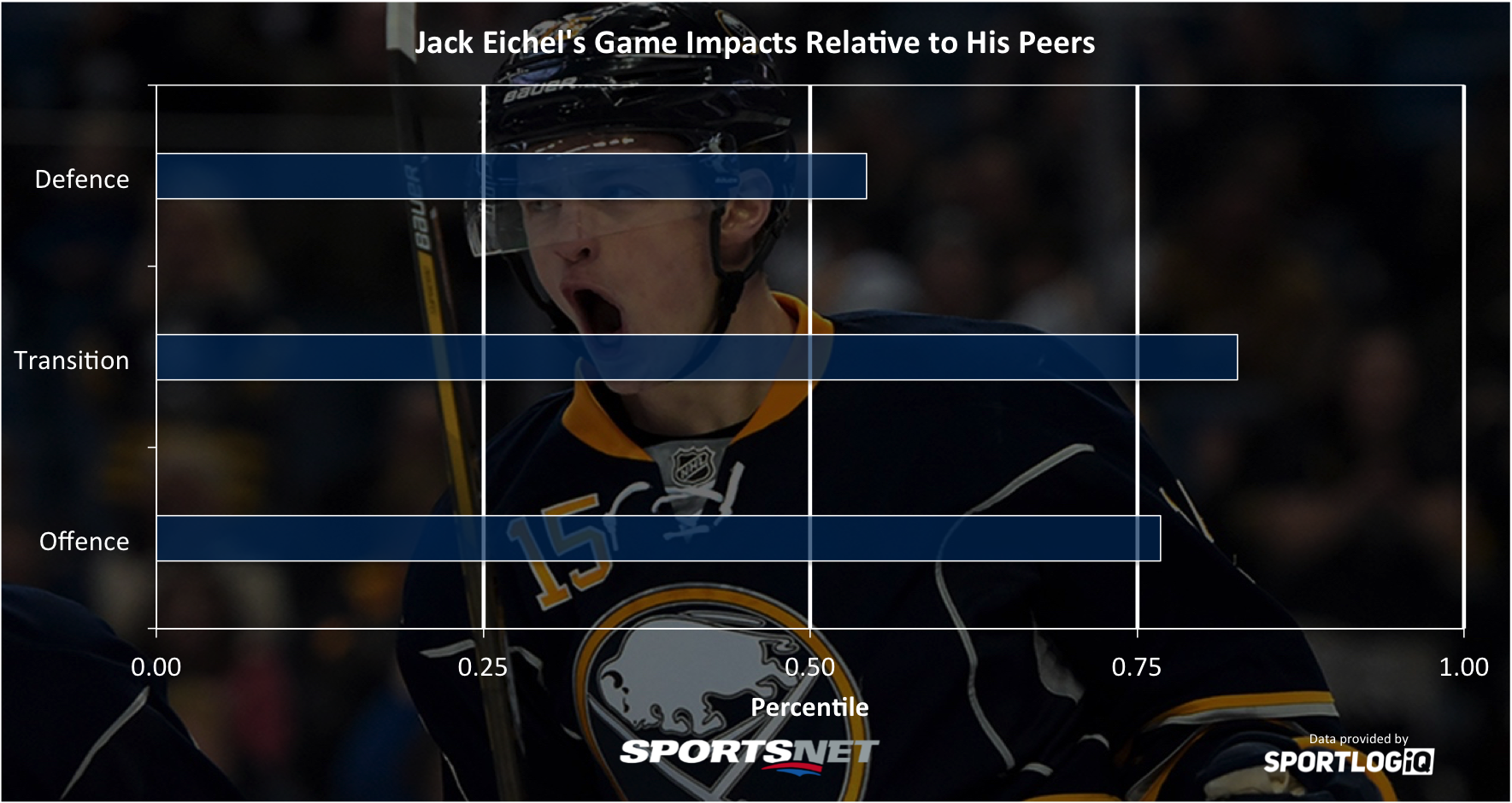
With the brilliance of Connor McDavid and the shining light on Auston Matthews in Toronto, Jack Eichel doesn’t get nearly enough press for how great he’s been in his first two seasons in Buffalo. Missing the start of last season sort of hid how dominant he was offensively, and for the second straight season he was one of the premier puck rushers in the NHL.
No one else in the league compiles as many successful transition plays per minute as Eichel, whether that’s clean zone exits and entries, breakout passes to teammates, or neutral zone passes that set up entries for others. Those contributions haven’t produced eye-popping possession numbers yet, but a big part of that is because Buffalo has been a mess for years, and his minutes are among the toughest anyone faces in the NHL. Don’t sleep on Eichel, he’s going to be great.
14. Nathan MacKinnon
Difficulty Matrix: 1.19/1.25
Offence: 32.80/50 | Transition: 20.21/25 | Defence: 13.27/25
Total: 66.28/100
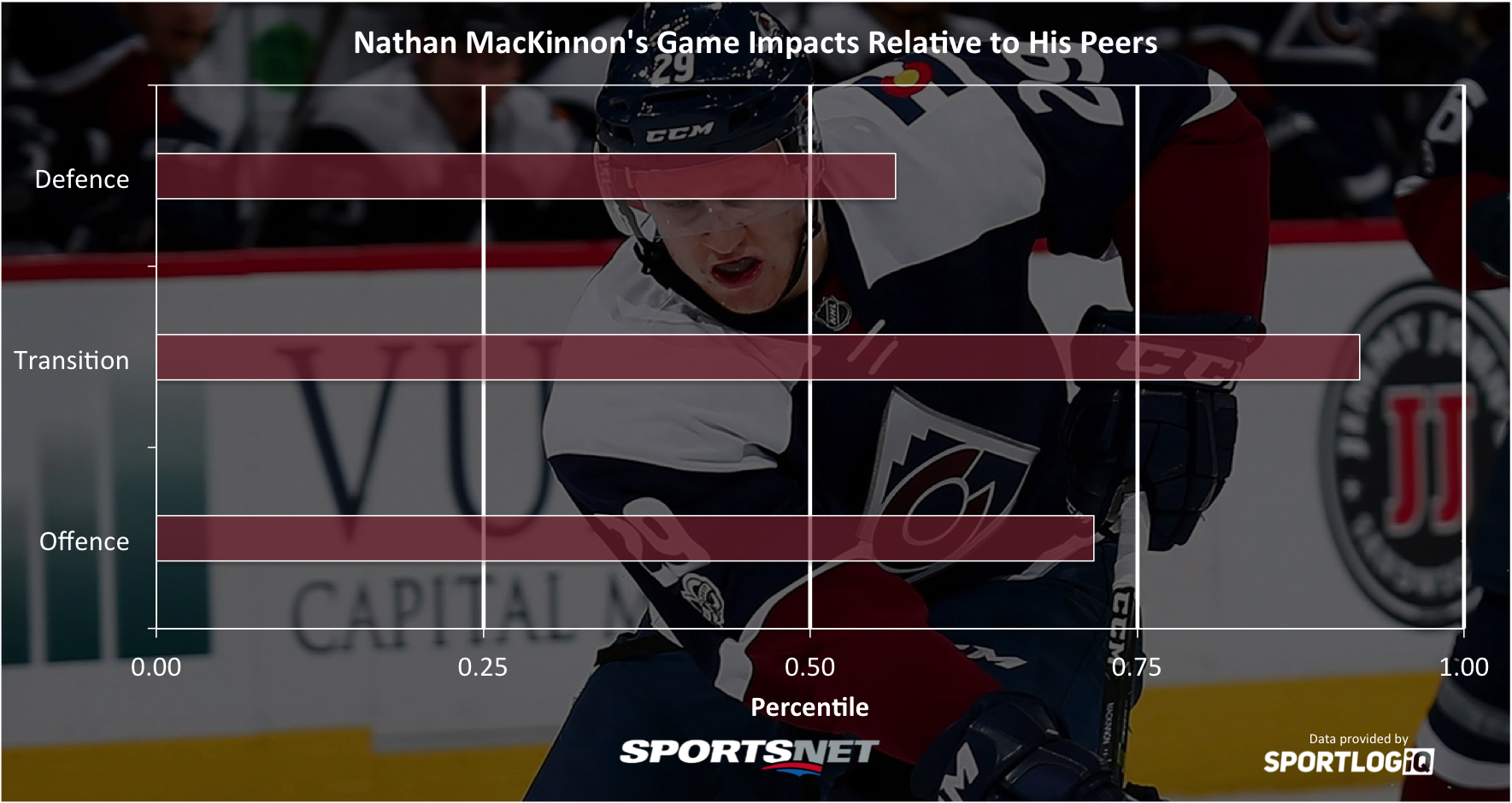
There’s a common misconception that Nathan MacKinnon has stagnated since his exemplary rookie season turned heads, but that’s nowhere close to true when you dig into the data. MacKinnon moves up five spots from last year with big improvements to every area of the game.
His biggest improvement has been to his defensive game, where he’s significantly cut down turnovers, and used his speed more effectively to change possession with loose puck recoveries. MacKinnon’s absurd skating ability makes him a transition beast, but he’s also started to work in more passing to use his linemates effectively and open up lanes for himself to get open. If not for Colorado’s disastrous last season, opinions of MacKinnon would likely be much higher.
13. Vincent Trocheck
Difficulty Matrix: 1.18/1.25
Offence: 29.43/50 | Transition: 19.05/25 | Defence: 18.44/25
Total: 66.92/100
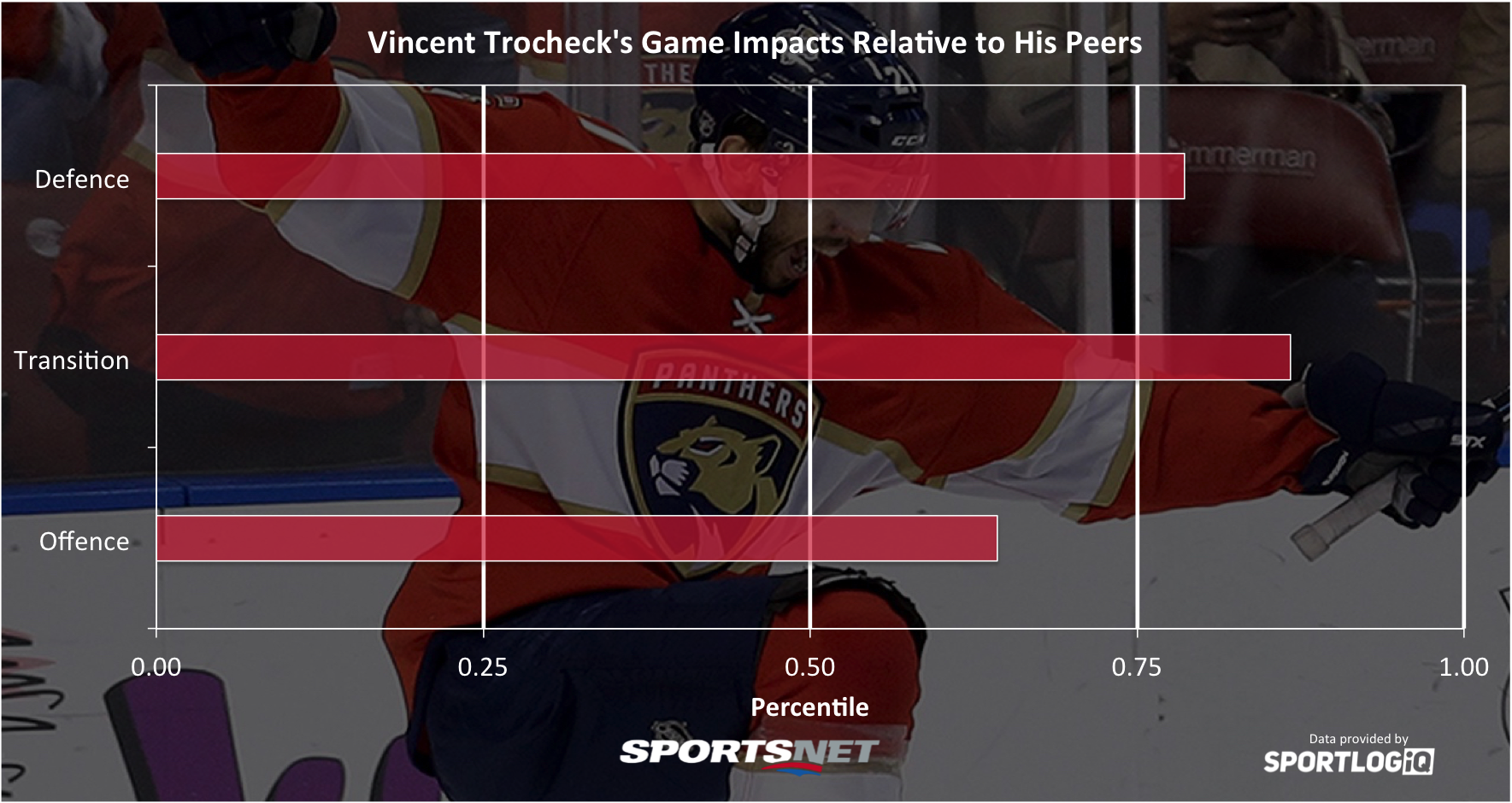
Hidden down in Florida is a little gem named Vincent Trocheck who not many people talk about. Trocheck has seen consistent improvement in his game over parts of four years in the NHL, and over the past two he has grown into a two-way force to be reckoned with. Unlike his teammate who will be further up this list, Trocheck doesn’t have the advantage of playing with exceptional wingers like Jaromir Jagr and Jonathan Huberdeau; he’s forced to get things done without as much help.
Trocheck is a very strong even strength scorer whose offence hasn’t translated to the power play yet, and when he’s on the ice he runs the Panthers’ transition game almost completely. He’s very involved in all areas of the ice, recovering loose pucks at an elite rate, and consistently stripping opponents with smart defensive plays.
12. Nicklas Backstrom
Difficulty Matrix: 1.14/1.25
Offence: 31.70/50 | Transition: 18.94/25 | Defence: 18.15/25
Total: 68.79/100

Refining the statistics a little bit this year led to Nicklas Backstrom moving up the list four spots, largely due to a more accurate representation of his defensive impact. Backtrom is a very unique player, because when most skaters attempt more high-impact, dangerous passes, their success rates plummet. The net effect is still positive, but with risk sometimes you get bit. Backstrom, though, maintains incredibly high pass success rates despite making many dangerous passes.
That passing ability doesn’t just apply to setting up Alex Ovechkin’s one-timer either, it’s about breakout passes from the defensive zone, setting up teammates for entries in the neutral zone, stretch passes for breakaways, and more. That passing ability also means Backstrom commits very few turnovers, meaning his teammates rarely have to make reactionary plays to defend his mistakes.
11. Anze Kopitar
Difficulty Matrix: 1.16/1.25
Offence: 28.13/50 | Transition: 21.96/25 | Defence: 19.13/25
Total: 69.22/100
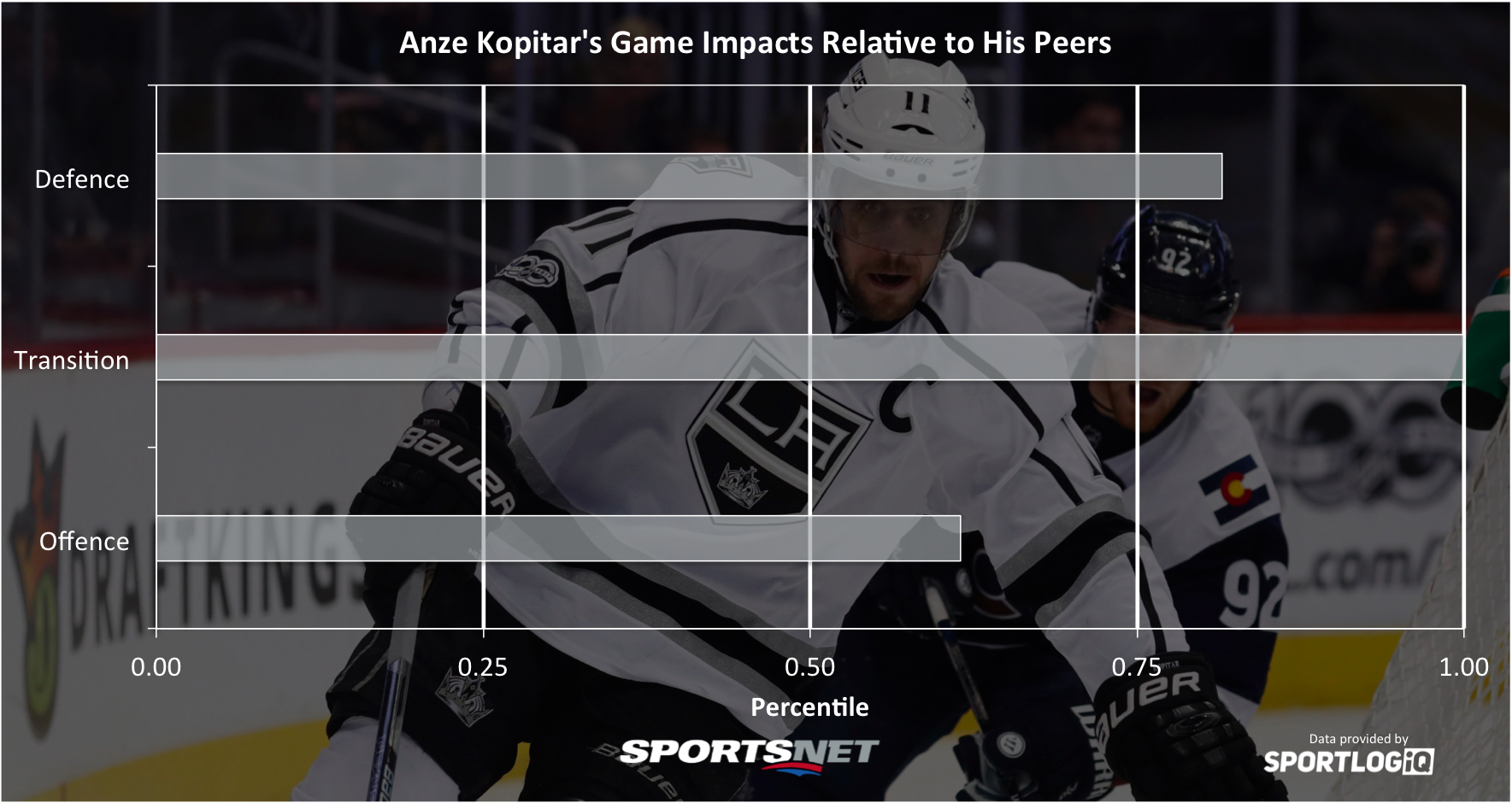
It’s not a surprise that Anze Kopitar fell from fourth last year to 11th after the season he just had, but it’s important to note that most of his struggles last year were due to a severe drop in his quality of teammates, not necessarily his play. Kopitar remains a defensive stalwart, but his standout skill is puck management.
Both defensively in terms of turnovers, and transitionally in terms of passing, no forward is as safe with the puck as Kopitar. He leads all centres in defensive zone passes and neutral zone passes per minute played, and in success rates for both, making the Kings’ transition game picture perfect when he’s on the ice. When passes aren’t available, he’s not afraid to rush the puck either, which he does more successfully than 95 per cent of players in the NHL.
10. Mark Scheifele
Difficulty Matrix: 1.17/1.25
Offence: 35.88/50 | Transition: 18.05/25 | Defence: 15.84/25
Total: 69.77/100
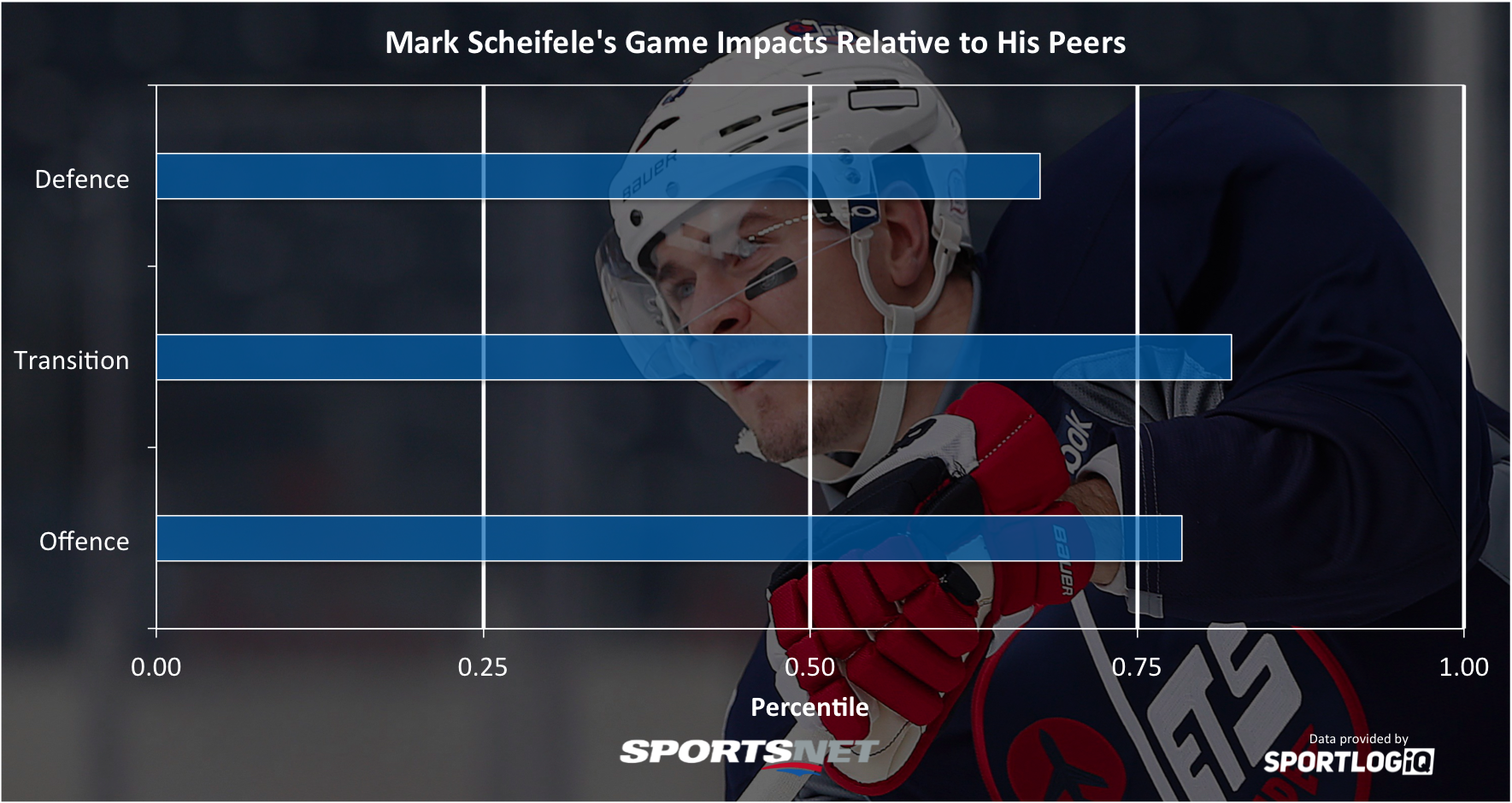
After a big debut on the list last year at 13th, Scheifele climbs a little more due to a significant improvement to his defensive play, and another strong offensive season boosting his already great offensive score. Scheifele actually attacked much differently last year than he had previously in his career, working hard to improve his playmaking and taking advantage of the ludicrous release that Patrik Laine possesses, which ended up diversifying his game and leading to even more points than his breakout season.
Scheifele also remained one of the more aggressive centres when it comes to fore-checking and loose puck recoveries, boosting his defensive numbers as his turnover rates dropped year over year.
9. Ryan Getzlaf
Difficulty Matrix: 1.17/1.25
Offence: 31.38/50 | Transition: 19.10/25 | Defence: 19.63/25
Total: 70.11/100
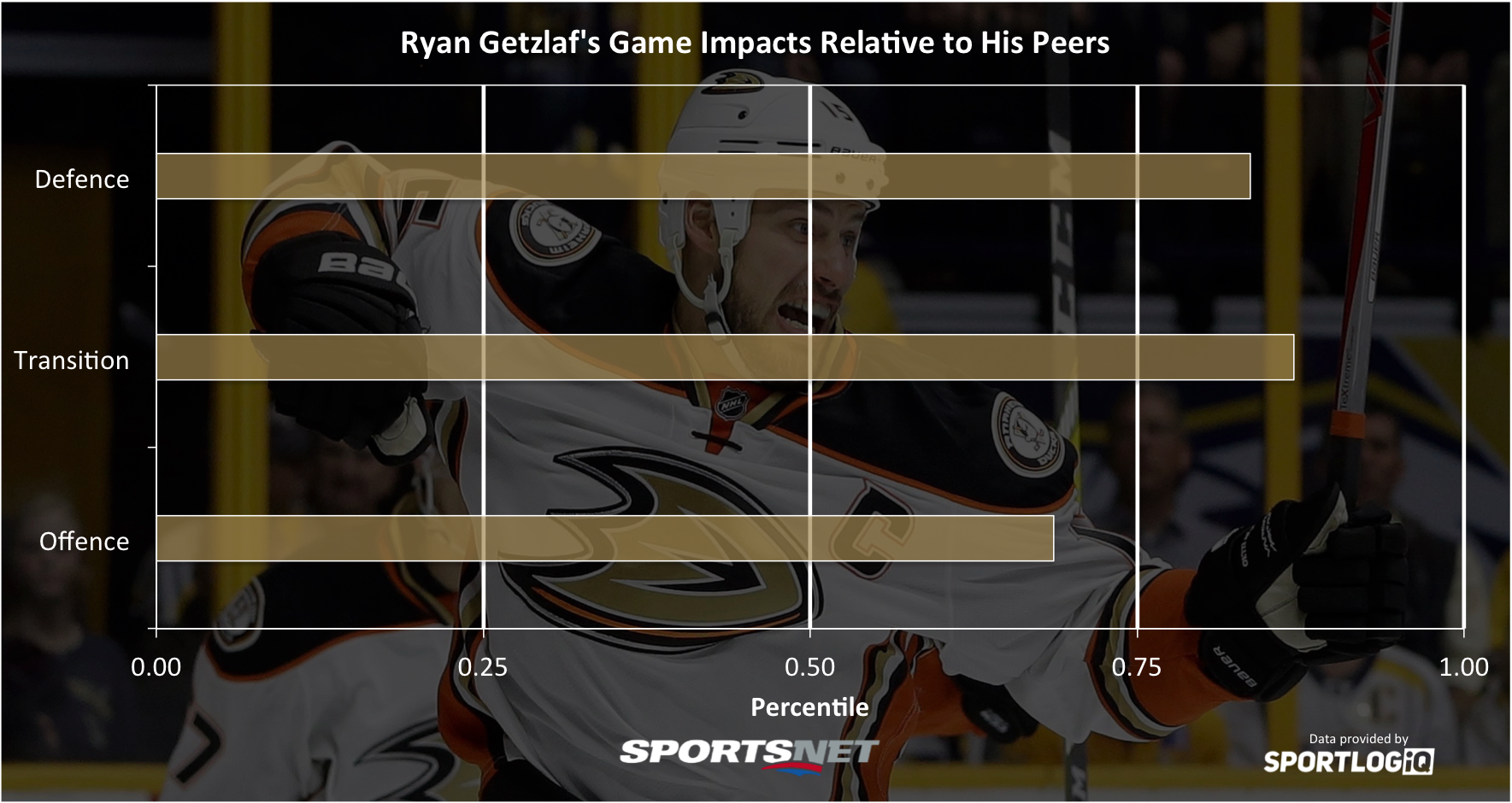
A habit of always looking to pass despite owning a devastating wrist shot will always hold Getzlaf back a bit offensively, but leading all centres in primary assists last year is a nice way to make up for it. Everyone who watches Getzlaf knows his passing creates most of his offence, so I want to focus on the rest of his game.
Speed isn’t an asset for him, and yet he’s one of the strongest transition players in the NHL. He accomplishes that mostly with smart passes out of the defensive zone and in the neutral zone, but despite a lack of foot-speed his quick hands and large frame allow him to lug the puck up the ice when he decides to, either deking around opponents or pushing through them while protecting the puck with his reach. His performance in the playoffs last year exemplified that ability better than perhaps any other time in his career.
His teammates likely don’t mind when he puts everything on himself to clean up defensively either, since he boasted the lowest defensive zone turnover rate of any center in the NHL last year.
8. Ryan O’Reilly
Difficulty Matrix: 1.21/1.25
Offence: 31.88/50 | Transition: 19.38/25 | Defence: 20.16/25
Total: 71.43/100

Another player who is chronically underrated, Ryan O’Reilly faced the toughest minutes of any centre in the NHL last season and excelled in them. O’Reilly is an incredibly rounded player, boasting a strong playmaking mind coupled with incredible transition skills and defensive instincts. He is nearly as aggressive without the puck as Scheifele, but couples that with almost never making a mistake with the puck relative to his peers, in all three zones.
In transition that rarity for making mistakes with the puck is a big contributor to his game, where he nearly matches Kopitar’s pass success rates relative to his teammates, and makes nearly as many passes as well. O’Reilly can do it all, in every situation, and doesn’t really have a glaring weakness to his game. He’s the kind of player every coach falls in love with, except for maybe Patrick Roy I guess.
7. Steven Stamkos
Difficulty Matrix: 1.15/1.25
Offence: 41.58/50 | Transition: 16.84/25 | Defence: 13.15/25
Total: 71.57/100
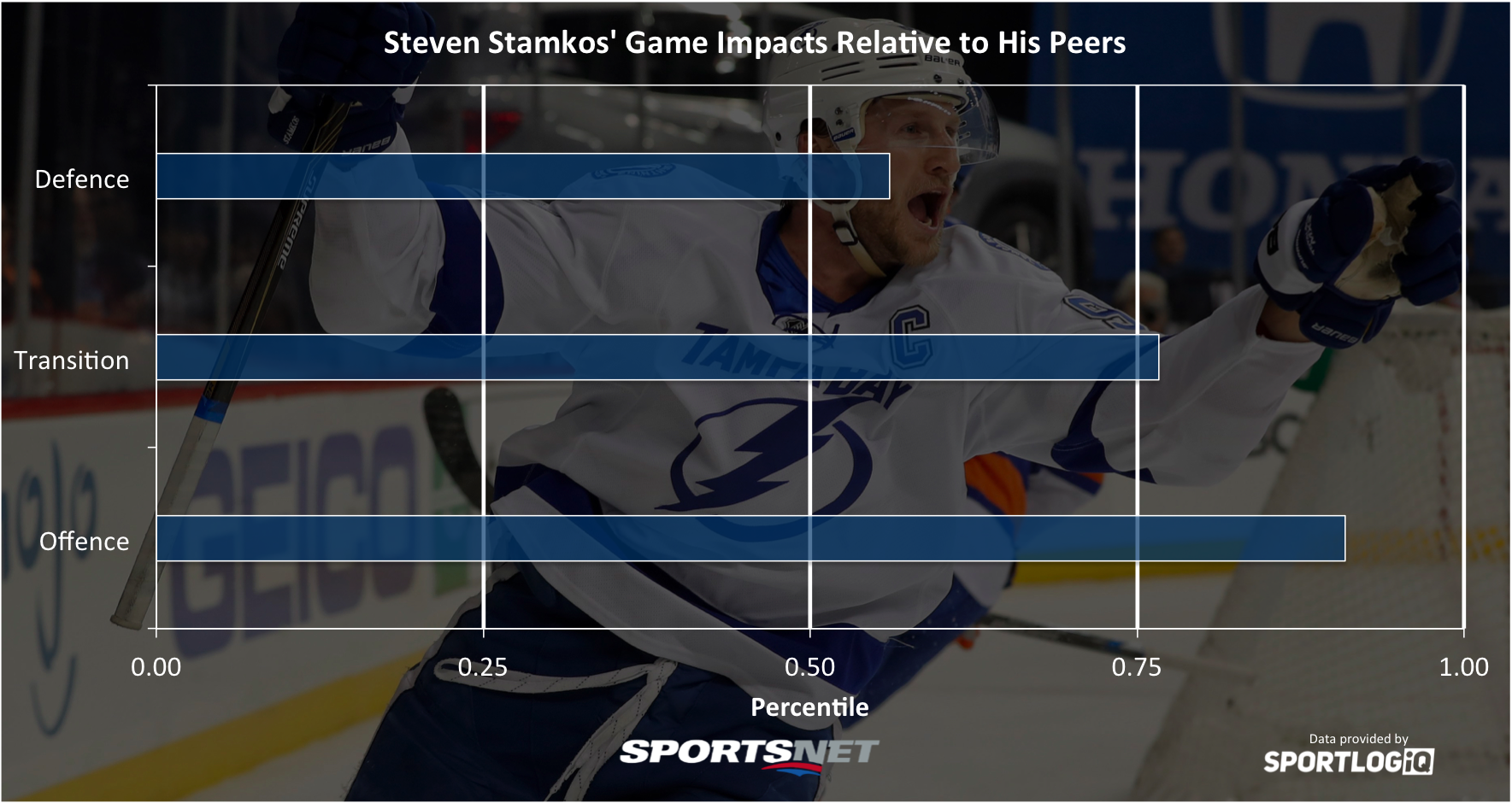
Absent from the top-20 last year, Stamkos was the biggest beneficiary of including new statistics and some re-working of the weightings to more accurately reflect on-ice effectiveness. Stamkos isn’t strong defensively, which may be why Jon Cooper tried him on the wing off and on for a while, but his offensive ability at the centre position is simply too strong to justify messing with his game.
Stamkos’ standout skill is obviously his shot, as he’s one of the only players in the NHL who can consistently score from outside the scoring chance ‘home plate’ area, but Stamkos is also quite the capable transition player, boasting strong controlled exit and entry numbers alongside excellent involvement in making passes forward through the neutral zone. A healthy year from him should have Tampa Bay among the toughest cup contenders.
6. John Tavares
Difficulty Matrix: 1.19/1.25
Offence: 35.90/50 | Transition: 19.23/25 | Defence: 17.05/25
Total: 72.19/100

Two years ago John Tavares was a liability defensively. One year ago he was average, perhaps slightly below. Last season he had the third-biggest defensive impact of any centre in the NHL — I’ve never seen any player change their game so quickly and effectively. After adapting his game when he broke into the NHL to be more than just a one-dimensional scorer by improving his skating and becoming an excellent transition player, he’s done the same again with his attention to detail without the puck.
Being able to essentially re-invent himself twice in one short NHL career — he just turned 27 — makes me respect Tavares’ approach more than pretty much any other NHLer. When he puts his mind to something, he will become elite at it in no time, that’s pure talent mixed with a fourth-line work ethic, sort of like Crosby.
Tavares has become increasingly willing to hold on to the puck instead of dumping it in and out of zones, leading to more offence off the rush and fewer turnovers, and when he doesn’t have the puck he has picked up his aggressiveness in winning it away from opponents. Adjustments in his defensive posture have led to huge, positive changes in his shot attempt differentials, as he no longer defends while focused on offence first. It’s incredible to watch.
5. Patrice Bergeron
Difficulty Matrix: 1.16/1.25
Offence: 32.36/50 | Transition: 18.15/25 | Defence: 23.46/25
Total: 73.96/100
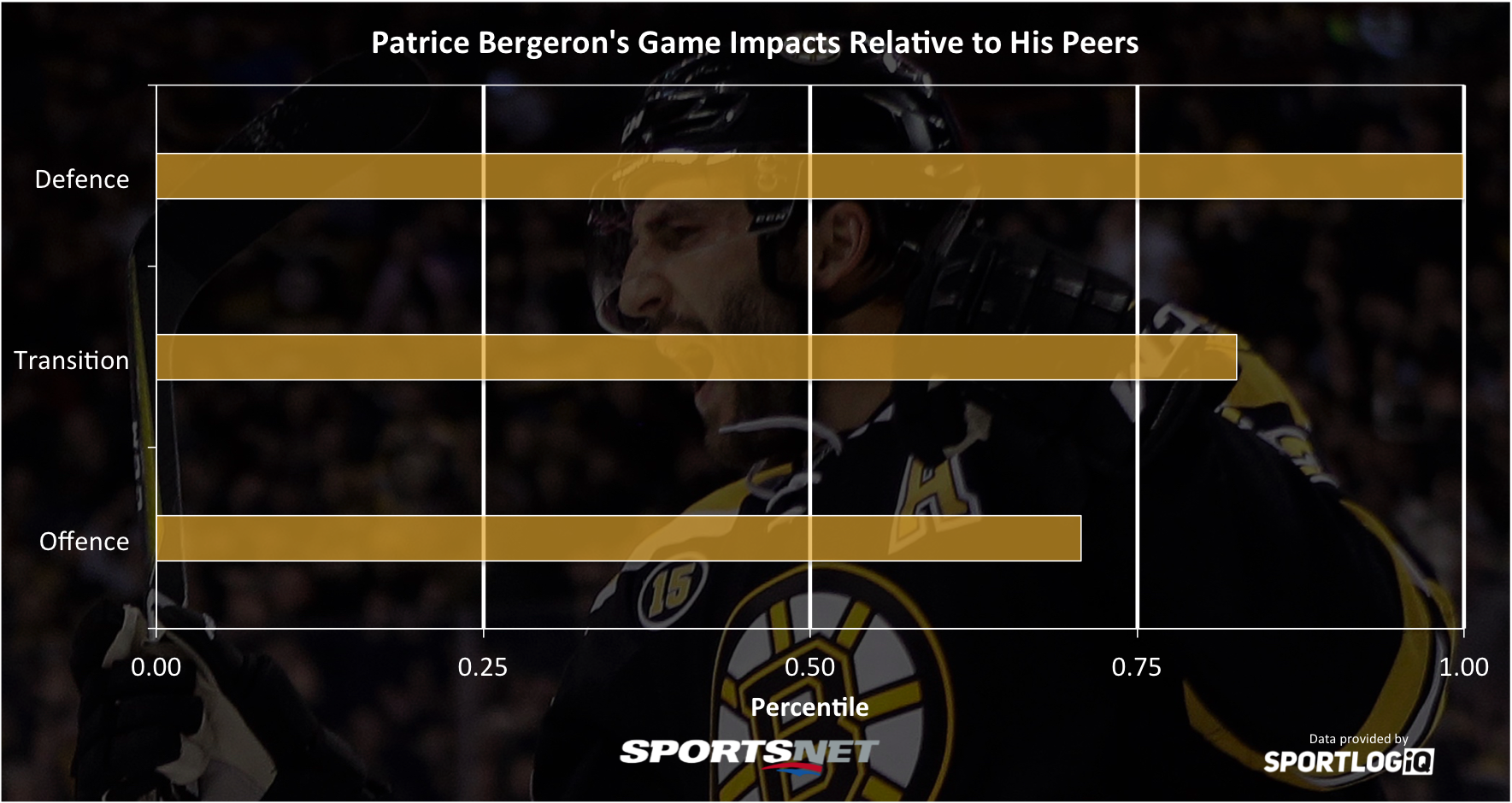
The reigning champion of defensive play is yet to be unseated, as Bergeron remains the best forward in the league at taking the puck away from opponents, limiting scoring chances against, and positionally supporting his teammates. But let’s not forget he’s also an ace transition player, and pretty excellent offensively.
Bergeron actually led all centres last season in shot attempts at 5-on-5 and was third in scoring chances. He’s also devastatingly strong on the power play, and of course no one can match him when it comes to shot attempt differentials.
Playing with elite offensive guys such as Brad Marchand and David Pastrnak does make his job much easier, but so far at age 32, there doesn’t appear to be much in the way of decline in his game.
4. Aleksander Barkov
Difficulty Matrix: 1.14/1.25
Offence: 36.01/50 | Transition: 20.77/25 | Defence: 20.30/25
Total: 77.09/100
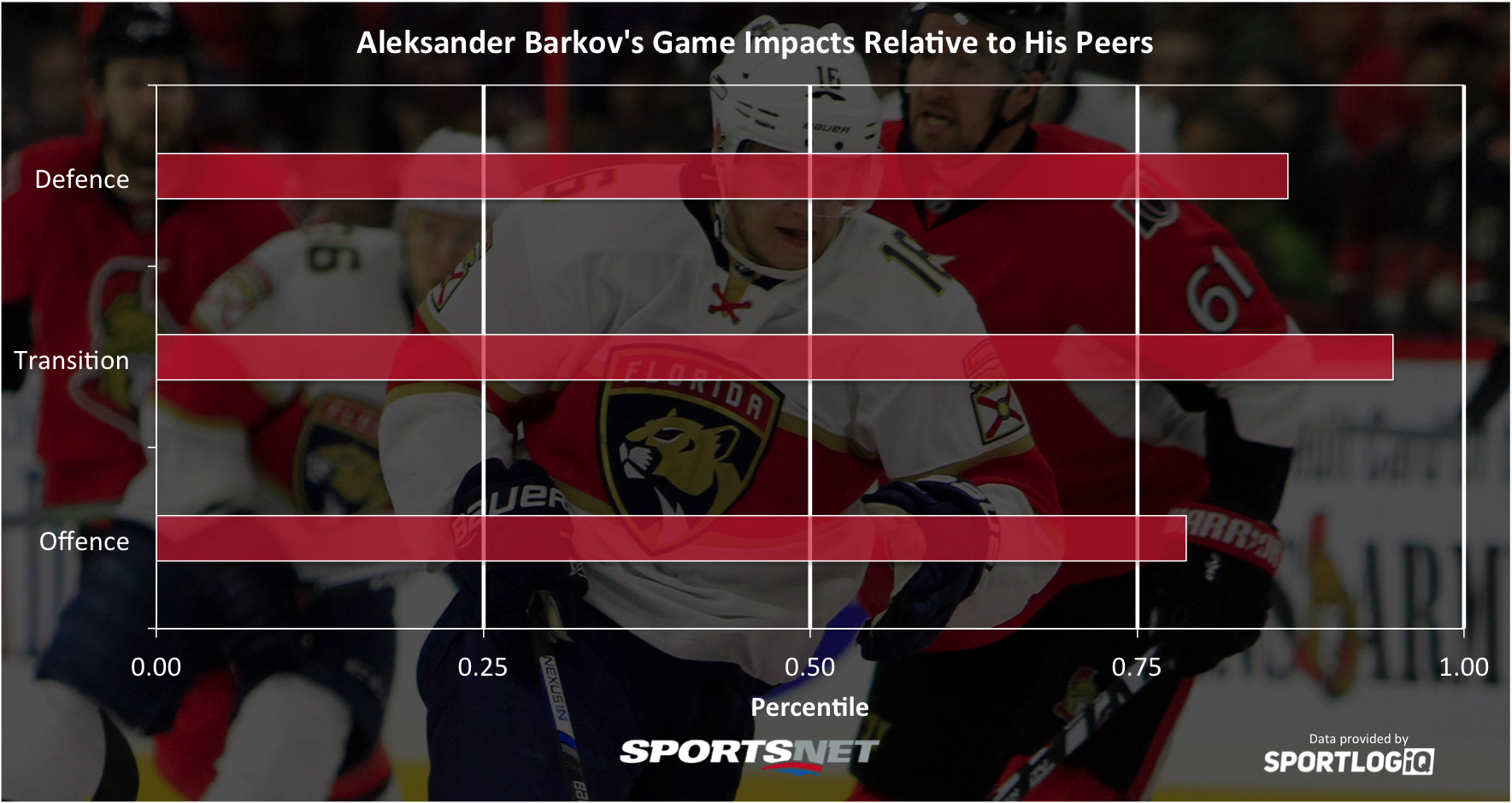
I was fairly surprised last year when Barkov showed up in the top 10 among NHL centres, and I was even more shocked when he jumped up to fourth this year. Don’t get me wrong, I think he’s awesome, but it’s a lofty position to be in. As it stands though, Barkov is the only NHL centre to be above the 75th percentile in all three areas of the game, making him arguably the NHL’s most well-rounded centre.
Barkov has some standout skills, but what pushes him to such lofty heights is that he’s just really good at… everything. Scoring, playmaking, defending, skating the puck up the ice, finding teammates in transition, recovering loose pucks, he does it all well. I suspect playing with Jaromir Jagr has some impact on Barkov’s numbers, but to assume his quality of teammates metrics impact more than any other player is a little unfair. This is a dynamite young player who Florida could build a championship team around.
3. Evgeni Malkin
Difficulty Matrix: 1.15/1.25
Offence: 42.11/50 | Transition: 21.04/25 | Defence: 16.67/25
Total: 79.81/100
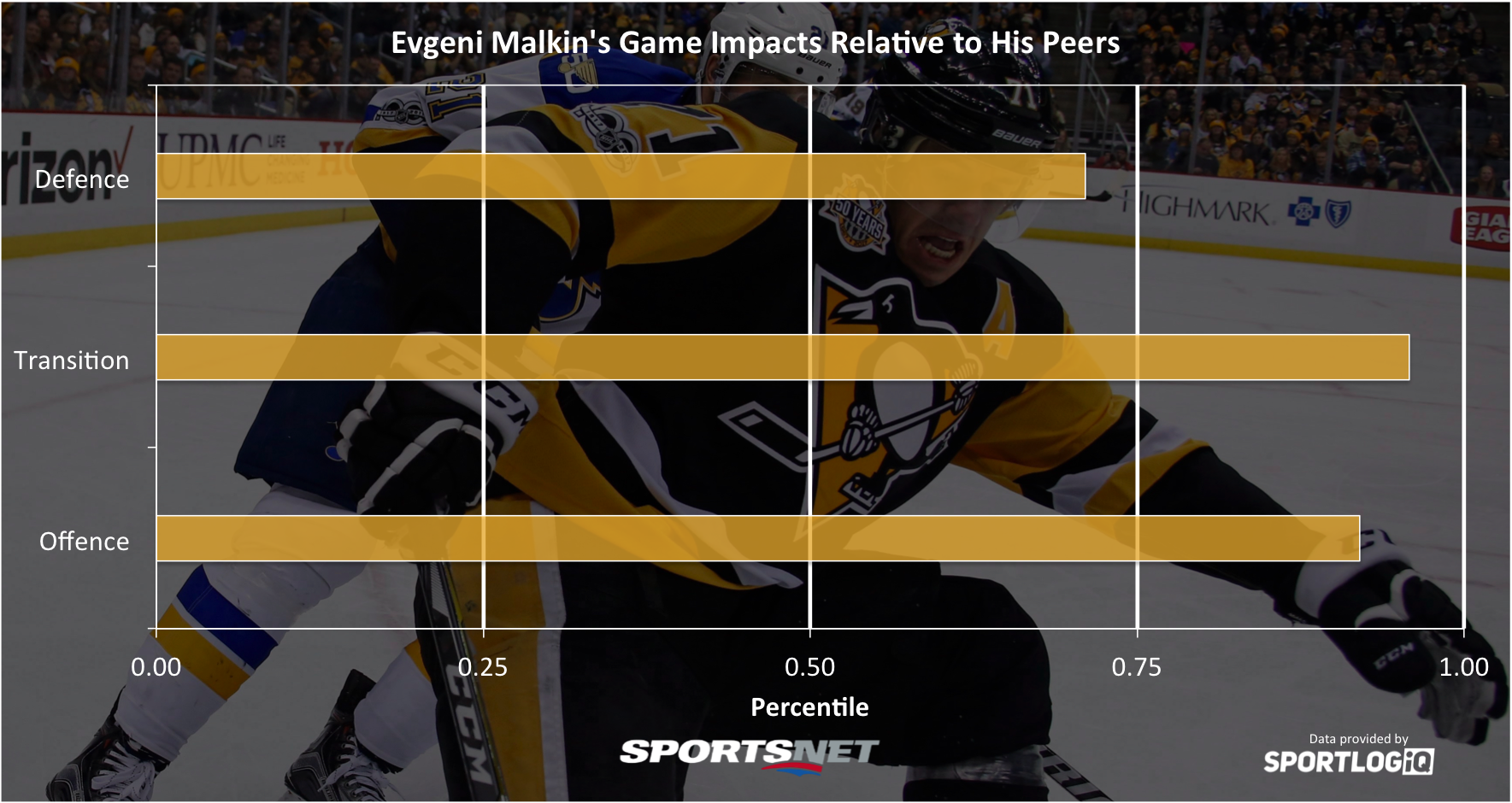
Malkin might be the most enjoyable player to watch in the NHL. Because he plays with absolutely no regard for his own safety, he’s focused only on getting that black rubber disc into the net. Malkin’s brute force strategy leads many to think he’s not a very well-rounded player, but that’s actually not true. His aggression can get him caught from time to time, but that same quality leads to a lot of possession changes in his favour, and tons of loose puck recoveries.
Malkin loves to keep the puck on his stick while rushing from his own zone all the way to the opponent’s net, and pretty much no one can stop him. He’s the modern day pinnacle of power forwards.
2. Sidney Crosby
Difficulty Matrix: 1.17/1.25
Offence: 45.74/50 | Transition: 19.95/25 | Defence: 14.89/25
Total: 80.58/100

The greatest player of his generation, for the first time in a long time Crosby is at No. 2. He’s probably fine with that after back-to-back Stanley Cups and Conn Smythe Trophies separated by a World Cup win and World Cup MVP, but for the moment it looks like he’s been surpassed.
The only thing really holding Crosby back is that he doesn’t play as much defence as he did earlier in his career, taking things a bit easier in the regular season compared to the playoffs. He also doesn’t play shorthanded, which cuts a chunk of available points out for his defensive score.
Crosby is still the single most effective driver of offence in the NHL, and he’s brilliant in transition as well, especially last year as he really focused on holding on to the puck through the neutral zone and drawing checkers towards him to free up quick linemates like Conor Sheary. Crosby may be No. 2, but not by much.
1. Connor McDavid
Difficulty Matrix: 1.20/1.25
Offence: 45.00/50 | Transition: 19.88/25 | Defence: 17.06/25
Total: 81.94/100
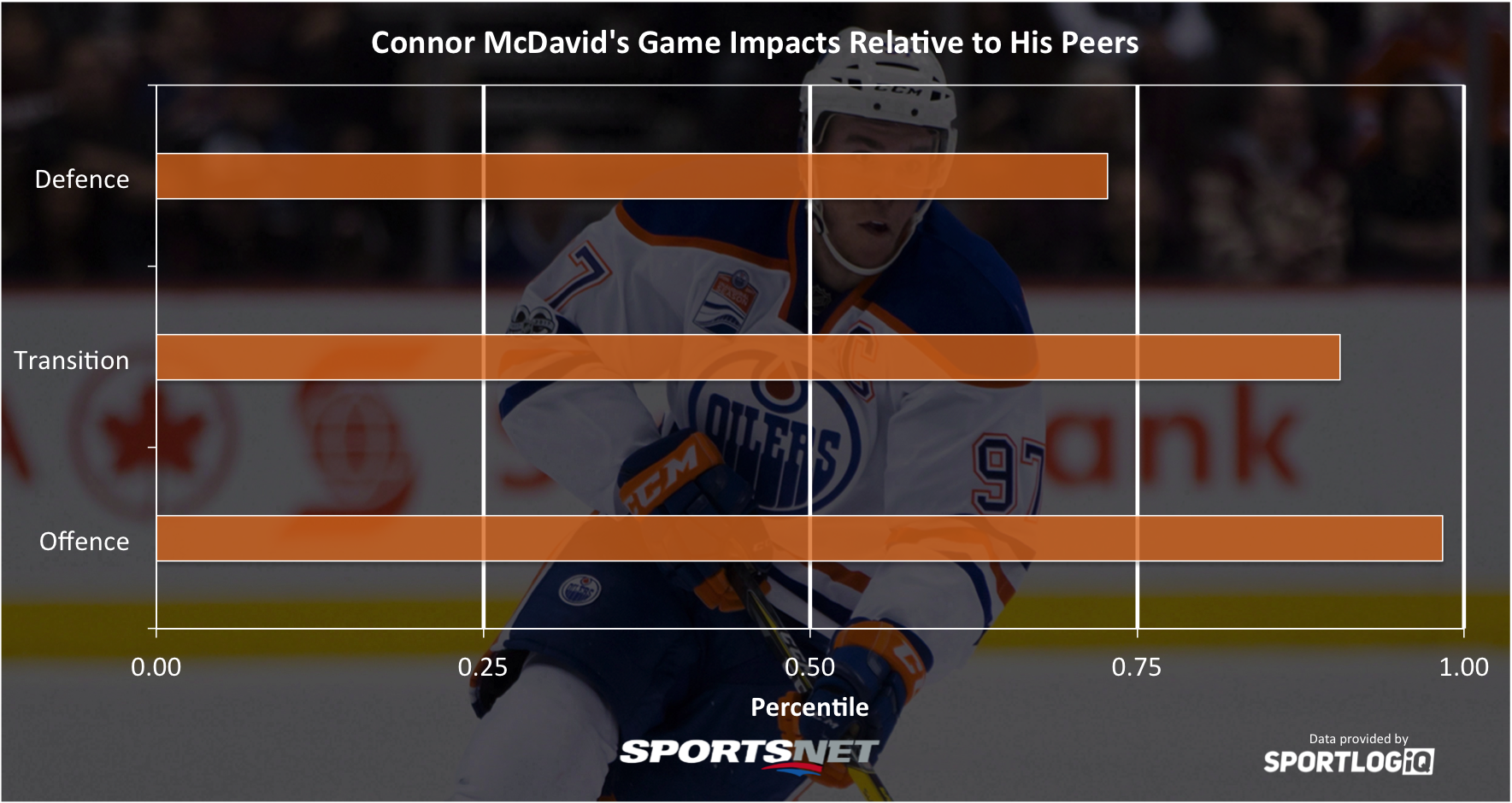
The new top centre in the NHL was a rookie just a year ago, and won his first Hart Trophy last season while leading the league in scoring with an aesthetically pleasing 30-goal, 70-assist, 100-point season. McDavid is right there with Crosby in terms of creating offence, and actually leads the NHL in high danger scoring chances per minute played the past two seasons.
With his skating ability it’s not at all surprising that McDavid crushes teams with his transition game, but at his age his defensive awareness and his ability to use his speed to break up plays displays a lot of maturity.
McDavid also happens to be an incredible penalty killer, with his speed keeping opposing defencemen afraid of moving the puck across the middle because of the threat of a breakaway chance by arguably the most talented player in the NHL. The crazy thing is McDavid is going to get better.
[relatedlinks]





